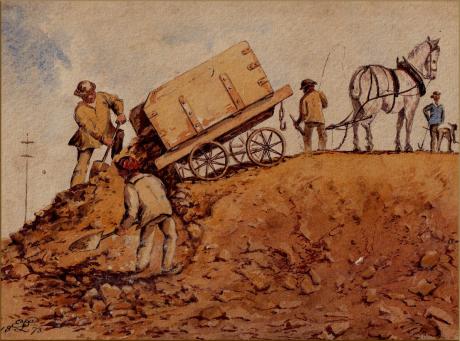inscribed on the mount " Tipping" Old garden Waste" and further inscribed with monogram and dated " E.T.L. 1873"
The tip cart has twin shafts, designed for a single horse secured between them, the farm cart has a rail to which may be attached either a pair of shafts (supplied as a U shaped set) or a sing pole, which could have a horse attached either side. The shafts tended to get in the way so when a cart or waggon with hinged shafts was 'parked' it was usual to get them out of the way. The top waggon has the single pole placed in the wagon (it would be placed under the wagon were it being loaded or unloaded). The two flat-bed waggons show positions used for securing the twin shafts (always tied back for safety) taken from photographs. Carts and waggons used for delivery work or for jobs such as hauling away the manure from stables were not fitted with a driving seat. The horse was either lead by the carter walking along beside the horses head and holding onto the bridle or controlled by voice commands and the use of a long whip. If the horse bolted the carter usually just got out of the way as quickly as possible. Reins first appeared on these vehicles in the mid nineteenth century but carters still preferred to walk or sit on the front corner of the waggon. In towns the local councils preferred the driver to ride on the waggon and use reins to control the horse, this increased the speed of the vehicle somewhat and having the driver high up gave him a better view of the road. It also meant that the driver would, in theory at least, be able to stop the horse bolting. In practice the latter depended to a large extent on the horse's temperament and how startled it had been. In 1900 a law was passed requiring all waggons to be driven with reins but many carters continued to lead their horses.

